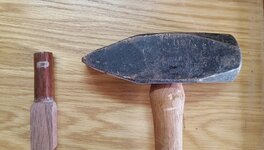BCnabe
Member
I'm curious to know what brand of CA people are using for your finish.
I originally started with Titebond because that's what the local Woodcraft had.
When pen orders picked up I wanted to buy larger bottles so I tried Stick Fast (thin and medium). It seemed to work okay but I saw some comments about Stick Fast "shattering". I had a pen do that so I decided to try the medium EZ-Bond.
I'm not sure if it's just me but it seems like I can't get the EZ-Bond to a high gloss finish like I used to with the other brands.
What I've been doing is using a few coats of the thin Stick Fast to seal the wood and then switching to the EZ-Bond medium for the final coats. The reason was that I was trying to use up the thin Stick Fast and I didn't have any thin EZ-Bond.
I have a bottle on thin EZ Bond on order. I'm going to try a comparison on the same piece of wood using EZ Bond thin and medium on one half and then thin Stick Fast / medium EZ Bond on the other half to see if I can tell a difference.
Has anyone else found a difference in shiny-ness from one brand to another? Has anyone used different brands of CA on the same pen?
Has anyone had issues with EZ Bond?
I originally started with Titebond because that's what the local Woodcraft had.
When pen orders picked up I wanted to buy larger bottles so I tried Stick Fast (thin and medium). It seemed to work okay but I saw some comments about Stick Fast "shattering". I had a pen do that so I decided to try the medium EZ-Bond.
I'm not sure if it's just me but it seems like I can't get the EZ-Bond to a high gloss finish like I used to with the other brands.
What I've been doing is using a few coats of the thin Stick Fast to seal the wood and then switching to the EZ-Bond medium for the final coats. The reason was that I was trying to use up the thin Stick Fast and I didn't have any thin EZ-Bond.
I have a bottle on thin EZ Bond on order. I'm going to try a comparison on the same piece of wood using EZ Bond thin and medium on one half and then thin Stick Fast / medium EZ Bond on the other half to see if I can tell a difference.
Has anyone else found a difference in shiny-ness from one brand to another? Has anyone used different brands of CA on the same pen?
Has anyone had issues with EZ Bond?

